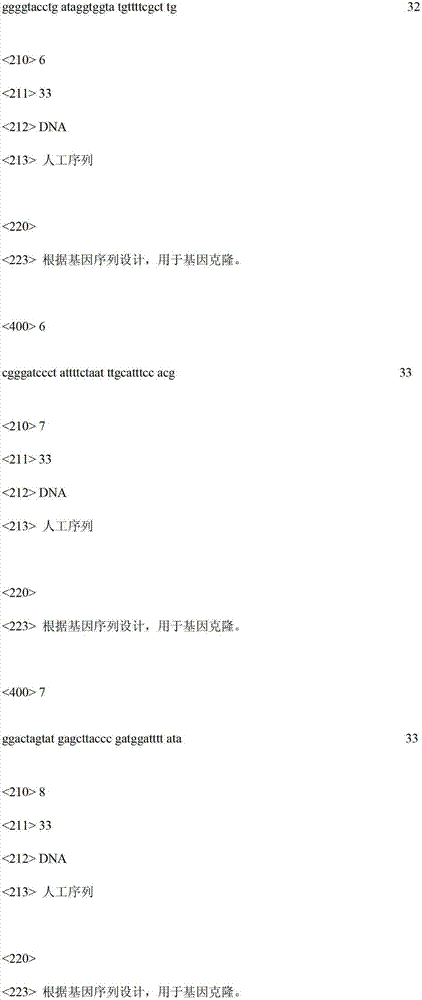Acetyl-glucosamine accumulating recombinant bacillus subtilis and application thereof
A technology of Bacillus subtilis and glucosamine, which is applied in the field of genetic engineering, can solve the problems of environmental pollution, serious, unsuitable for people with seafood allergy, etc., and achieves the effects of easy use, simple construction method and good application prospect.
- Summary
- Abstract
- Description
- Claims
- Application Information
AI Technical Summary
Problems solved by technology
Method used
Image
Examples
Embodiment 1
[0022] The construction of embodiment 1 recombinant plasmid
[0023] According to the nucleotide sequence of the glucosamine acetylase encoding gene (GNA1) in Saccharomyces cerevisiae S288C (purchased from the American Type Microorganism Collection, No. ATCC 204508) published on NCBI, such as SEQ ID NO.1, the primer GNA1-F5' was designed -GGGGTACCATTATAGGTAAGAGAGGAATGTACACATGAGCTTACCCGATGGATTTTATA-3', GNA1-R: 5'-CCCAAGCTTCTATTTTCTAATTTGCATTTCCACG-3'. The gene encoding glucosamine acetylase (GNA1) was amplified from the Saccharomyces cerevisiae S288C genome using the above primers. The amplified fragment was digested with KpnI and HindIII and then ligated into the pP43NMK expression vector (kindly provided by Dr. Zhang Xiaozhou, Virginia Tech, USA). Restriction digestion and sequencing confirmed the successful construction of the recombinant plasmid pP43-GNA1.
Embodiment 2
[0024] The construction of embodiment 2 recombinant Bacillus subtilis
[0025] The constructed expression vector pP43-GNA1 was transformed into Bacillus subtilis (Bacillus subtilis 168, purchased from Bacillus Genetic Collection, Ohio State University, USA). GNA1-F and GNA1-R primers were used to select transformants for colony PCR, and a 480bp band appeared, verifying that the recombinant Bacillus subtilis was successfully constructed.
Embodiment 3
[0026] Example 3 Fermentative production of acetylglucosamine
[0027] The seeds cultivated at 37°C and 200rpm for 12h were transferred to the fermentation medium with an inoculum size of 5%, and cultivated at 37°C and 200rpm for 30h. Finally, the content of acetylglucosamine in the fermentation supernatant reached 115mgL. The extracellular accumulation of acetylglucosamine in recombinant Bacillus subtilis was achieved by overexpressing the gene encoding glucosamine acetylase (GNA1).
[0028] Comparative Example 1 Integrated expression of GNA1 to accumulate acetylglucosamine
[0029] According to the pP43NMK plasmid sequence (GenBank accessionno.DQ264732) published on NCBI and the glucosamine acetylase coding gene (GNA1) in Saccharomyces cerevisiae S288C, the primer GNA1-2-F was designed: 5'-GGGGTACCTGATAGGTGGTATGTTTTCGCTTG-3', GNA1 -2-R: 5'-CGGGATCCCCTATTTTCTAATTTGCATTTCCACG-3'. The above primers were used to amplify the GNA1 expression cassette from pP43-GNA1, and the amp...
PUM
 Login to View More
Login to View More Abstract
Description
Claims
Application Information
 Login to View More
Login to View More - R&D
- Intellectual Property
- Life Sciences
- Materials
- Tech Scout
- Unparalleled Data Quality
- Higher Quality Content
- 60% Fewer Hallucinations
Browse by: Latest US Patents, China's latest patents, Technical Efficacy Thesaurus, Application Domain, Technology Topic, Popular Technical Reports.
© 2025 PatSnap. All rights reserved.Legal|Privacy policy|Modern Slavery Act Transparency Statement|Sitemap|About US| Contact US: help@patsnap.com



